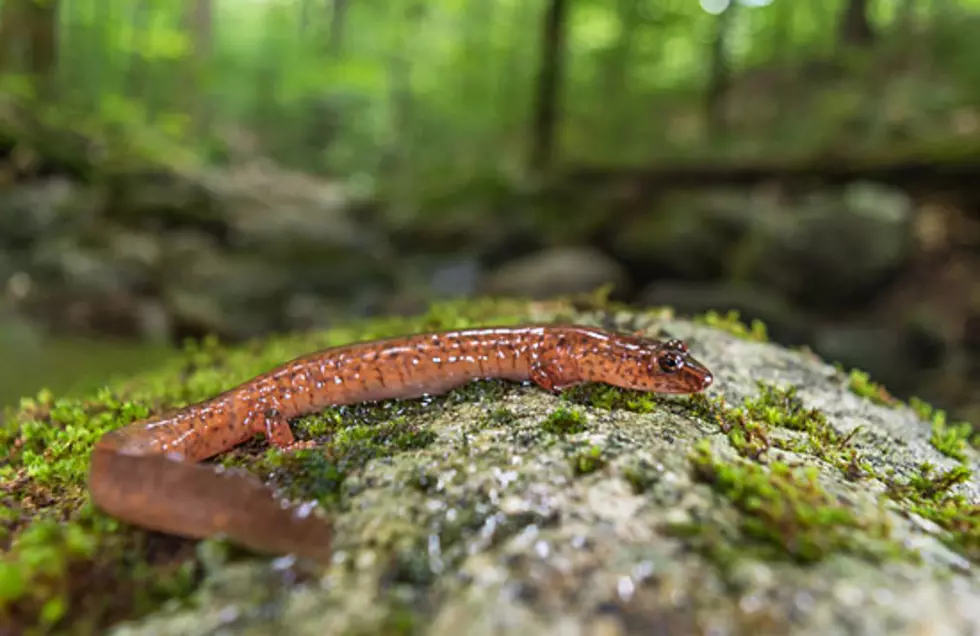
UM salamander research shows climate change effects, need for small stream protection
A University of Montana ecologist says rising summer temperatures are not the only climate change byproduct that wildlife species must deal with. Unpredictable shifts in precipitation can be disastrous as well.
Biology professor Winsor Lowe may work on the Missoula campus, but for 20 years he’s spent his summers in New Hampshire trying to sample spring salamanders, a species of amphibians found throughout the more mountainous regions along the East Coast from Alabama and Georgia to Maine.
Every year, he’s returned to the same 1-kilometer stretch of Merrill Brook in northern New Hampshire and spent a day or two turning rocks over, searching for small brown or reddish salamanders. With each passing year, he’s found fewer and fewer adults.
“It’s declined significantly: about 50 percent, although there’s a lot of variability,” Lowe said this week.
The thing is, Lowe and his fellow researchers have found no related decrease in the number of larvae. During the summer, female salamanders lay their eggs under rocks in a stream and the eggs hatch in the fall. The larvae then hang out in slow-moving water while they go through a slow metamorphosis over a year or two, changing into adults.
Each year, the researchers found plenty of youngsters, but then something would happen to them, so fewer made it to adulthood.
To try and understand what that something could be, the researchers looked at three years worth of streamflow data from Merrill Brook and four nearby streams. The data clearly showed that the flows are becoming more variable.
Climate change is causing the Eastern U.S. to become wetter, mainly because summer storms are becoming more intense. Lowe said areas get “huge dumps of rain” before drying out again, rather than regular summer showers.
That means the consistently slow-moving water that larvae once depended on in the summer isn’t always so slow-moving anymore. In years with more big storms, the streamflows were more erratic. Those were also the years that Lowe found fewer adult salamanders.
“The increase in the variability of flows could be the reason we’re seeing a drop in the number of adults. Specifically in the summer,” Lowe said. “We also looked at what’s going on in the winter and the spring. But we found those hydrologic patterns don’t explain the variation in survival.”
Lowe recently published his findings in the scientific journal, Proceedings of the National Academy of Sciences of the United States of America.
While decreases in the number of adult salamanders aligned with more erratic water years, Lowe and other biologists still don’t know why more larvae tended to disappear in those years. So Lowe’s next step is finding that out, although it will be a big challenge with things as small and reclusive as salamander larvae.
“What exactly is going on? Are they getting flushed out of rocks? Are they getting stranded and drying out during the low flows? That’s what we need to figure out,” Lowe said.
The salamanders of New Hampshire are not the only animals threatened by changes in streamflow brought on by climate change. Scientists are discovering species in the Rocky Mountains that are also struggling, although so far, the main variability in Montana streams is showing up in the spring.
There, climate change is causing streams to have more than one peak during spring runoff or it’s shifting the timing of the spring runoff.
That’s causing problems for native fish such as westslope cutthroat trout that spawn in the spring. Harlequin ducks are also being affected because they lay their eggs close to mountain streams normally after the peak flow. But the eggs end up being swept away if a second peak comes along.
Scientists are only now finding such connections that show as climate change worsens, stream-dependent species may not be able to survive.
That’s all the more reason that small headwater streams need protection, Lowe said. However, that will get more difficult with this week's announcement that the Trump administration is eliminating some of the protection provided by the Clean Water Act.
“Small headwater streams are home to diverse species and the source of clean water to downstream communities, but these ecosystems are also easy to overlook and are losing protection under proposed Clean Water Act revisions,” Lowe said. “Our work underscores the vulnerability of headwater ecosystems in this era of climate change, the need for protection of vulnerable headwater species, and the value of long-term monitoring efforts.”
Contact reporter Laura Lundquist at lundquist@missoulacurrent.com.
